C is for cost: Cat care in crisis
Get past clients' bias against spending money on veterinary services for cats with the dvm360 Leadership Challenge.
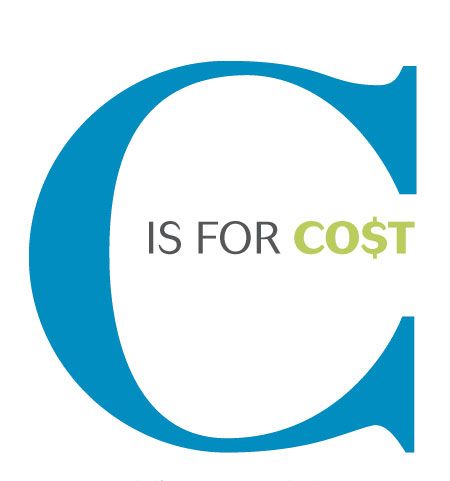
The most significant reason veterinarians don’t see more cats is cost. Cat clients are cost-sensitive and difficult to get through the door—but with 74 million household cats and 50 million more feral or community cats in the United States, cats are a virtually uptapped market. In this Zoetis-supported edition of dvm360’s Leadership Challenge: “Cat care in crisis,” you’ll learn how to break down clients’ bias against spending money on veterinary services for cats.

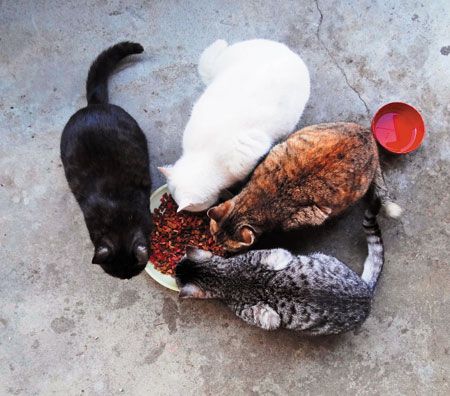
All photos from Getty Images
As the most popular pet in North America, cats represent a tremendous opportunity for the veterinary profession. The most recent American Veterinary Medical Association census estimates that there are 74 million cats owned as pets and another 50 million feral or “community” cats in the United States. While dogs visit the veterinarian an average of 2.6 times per year, those cats that see a veterinarian at all visit just 1.6 times per year—about half as often as dogs. This makes the feline sector the biggest untapped growth opportunity for companion animal veterinarians.
So what’s preventing cats from accessing veterinary healthcare regularly? There are many reasons that veterinarians see only about half as many cats as dogs, but the most significant reason is cost. Cat owners simply don’t want to pay—or can’t pay—traditional veterinary fees. That was one of the key findings of the recent Bayer Veterinary Care Usage Study III: Feline Findings.
Cost, coincidentally, is also one of the hardest obstacles for a veterinary practice to overcome, since many practice owners are struggling to grow revenue and compensate themselves and their staff properly. Regardless, there are ways that every practice can make veterinary services more financially attractive to cat owners.
Cat owners are more price-sensitive than dog owners for several reasons. One factor is that the vast majority of cats were acquired for free. Most pet cats were chance acquisitions for their owners, who more often report that “the cat found me” rather than the other way around. Plus, many people acquire cats precisely because they perceive them to be low-cost pets—cheaper to feed and requiring less care of all kinds. Cat owners also believe that their own cats are extraordinarily healthy and in need of very little veterinary care. This misconception makes a strong case in their minds for avoiding the veterinary practice.
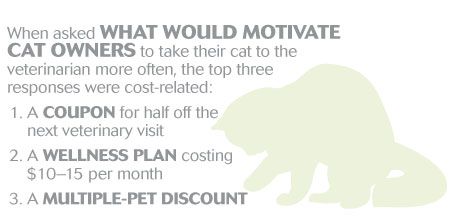

There are four ways to address cat owners’ bias against spending money on veterinary services and begin to tap into the opportunity. Let’s take a look at each strategy in turn.
1. Make routine costs economical
From the Bayer study it was clear that while cat owners were much more willing to open the purse strings to treat a sick or injured cat, they balked at spending money for routine wellness care. The Catch-22 is that by failing to bring in his or her cat for routine annual checkups, the owner is not likely to know that the cat has a health problem that requires treatment. Early disease detection is a money-saving strategy of value to cat owners, according to the study.
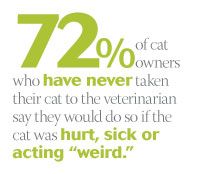
There are two lessons to be gained here: First, when it comes time to review fees, keep fees as economical as possible for wellness services and take increases where needed on therapeutic procedures. Second, at every opportunity, reinforce to cat owners the value of routine exams in detecting problems early to avoid costly treatments for later-stage problems.Generally, there are two times when owners expect to spend more money on veterinary care:
> When the cat is a kitten that needs to be spayed or neutered and requires a full set of vaccinations.
> When the animal is older and encounters geriatric health issues. The challenge for veterinary practices is to keep routine wellness exams for adult animals in the 2- to 10-year-old age range as streamlined and economical as possible. Remember that it’s more profitable to see more cats annually and earn a bit less on each one than to not see them at all.

2. Reward desired behavior
Most people, including cat owners, are far more likely to comply with good healthcare recommendations if you recognize the efforts they are making and reward them for it. There are several ways to use positive reinforcement to increase cat visits.
> Multi-pet savings. The majority of cat owners have multiple cats. If your practice does not already do so, offer a modest multi-cat discount.
> Tiered wellness. Increase the discount if each cat is brought in for a wellness exam within a year of its last visit. For example, let’s say your practice offers a 10 percent discount for the second and subsequent pet. Then consider offering a 15 percent discount for the second and subsequent cat if they are brought in annually.
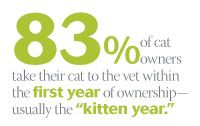
Why give up that revenue, you ask? (Or, to use the dreaded “d” word, why should you discount?) The fact is, your practice will actually start gaining additional revenue if more cats are brought in for annual visits. The patient your practice doesn’t see regularly is the one on which the most revenue is lost.
> One-time offers. Consider offering a 20 percent discount on an exam for a pet that has not been seen regularly. For example: A client brings in her dog religiously but not her two cats. Tell her that if she brings in her cats, they will each get 20 percent off the exam. This can be an easy one-time offer to get cats back into the practice.
> Turn slow days into cat days. Most practices have a couple days of the week, or parts of certain days, that are typically slow. Perhaps Thursdays are slow at your practice. Turn Thursdays into cat-only days and offer reduced-cost exams for cats that have not been seen in the last 12 months. Promote this service to all of your lapsed cat-owning clients. Turning a slow day into a busy day with cat visits increases your revenue, even if the income on each exam is a bit less. A value-added benefit is that cat owners prefer to bring in their pets when there are no dogs in the waiting area.
In these cases, discounting services is not a matter of simply cutting fees. Rather, it’s a way of rewarding those clients for purchasing services they would not otherwise buy.
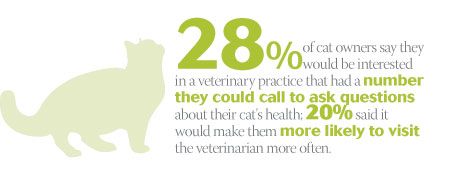
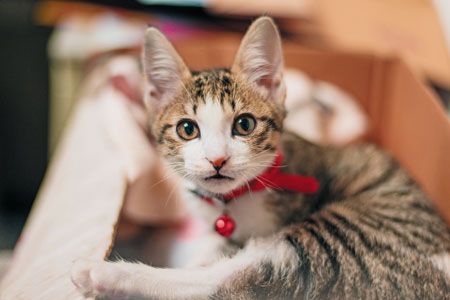
3. Expand payment options
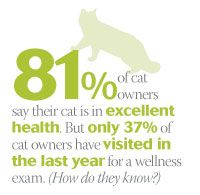
Remarkably, the Bayer Veterinary Care Usage Studies have demonstrated that many pet owners do not know about their veterinarians’ payment policies. It’s vital to educate all of your clients on which credit cards are accepted and whether or not you offer third-party payment programs such as CareCredit.
Clearly, one of the biggest ways to make an impact on feline visits is to offer preventive care plans paid in monthly installments. In the Bayer feline study, 40 percent of cat owners indicated that they were more likely to visit the veterinary clinic, or visit more often, if the practice offered wellness plans costing $10 to $15 per month.
Such plans are feasible for virtually any practice. Here’s an example. Let’s say your routine wellness visit for an adult cat includes the following:
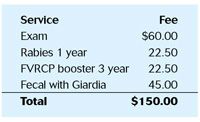
These are some typical prices used for illustration purposes. Prices will vary from practice to practice. Also, the example does not include products such as parasite control drugs because wellness plan experts have found that these programs work best when based on services, not products.
In the case above, the total cost is $150 for a typical visit. Divide that into 12 installments and it’s only $12.50 per month. Add a $3 service charge for monthly billing and it’s only $15.50 a month—a figure that a very large number of cat owners, including many who do not regularly visit the veterinarian, said they would find attractive. Keep in mind there are no discounts applied here—just standard fees for each service. It is not uncommon for practices with wellness plans to offer modest discounts in exchange for a full-year commitment to veterinary care.
Is this feasible for your veterinary practice? Yes. There are a number of companies in our industry that will provide full-service, turnkey wellness plan services at reasonable costs. For example, Preventive and Wellness Services (PAWS), a service from Veterinary Pet Insurance, charges $2.95 per month per wellness plan client, plus a onetime setup fee. This includes service fees on all the credit card transactions. You can also set up a do-it-yourself wellness plan program using tools available for free at PartnersforHealthyPets.org, a site sponsored by a coalition of veterinary companies and professional organizations, including the American Veterinary Medical Association (AVMA) and the American Animal Hospital Association (AAHA).
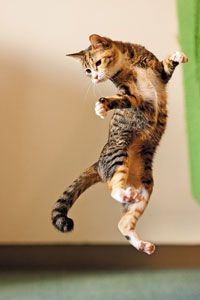
4. Maximize perceived value
In addition to managing costs and providing payment options, it’s critical that veterinarians provide a high level of perceived value to clients. Obviously, the greater value a cat owner places on veterinary services, the less frequently cost becomes an obstacle. Value is primarily a function of service and communication. Here are some ways to maximize perceived value in your veterinary practice:
> Consistency. Have the client see the same veterinarian during every visit. People want to establish a relationship with their own doctor—whether it’s a physician, dentist or OB-GYN—and see the same doctor every time. They want the same thing for their pet, according to the Bayer study.
> Carrier help. Before each visit, provide information to clients on how to acclimate their cat to the carrier and transport it to the practice with as little stress to the owner and animal as possible. Also, inform the owner what behavior to expect once the cat returns home. Remember, the appointment doesn’t start when the client arrives at your practice. It starts in the home and ends when the client returns home.
> Customized care. Provide a cat-friendly waiting area separated from dogs and a cat-only exam room
if possible. The American Association of Feline Practitioners’ Cat Friendly Practice program can guide your practice toward less-stressful visits (see catvets.com for more information).
> Client involvement. Talk through the exam with the client, explaining in detail what body part you’re examining, why you’re palpating this and looking and that, and what you’re finding as you go along.
> Report cards. Send a printed report home with the client, explaining your exam findings and what additional services or procedures were performed, if any. Owners also like it if you provide instructions on the care they should give their cat during the course of the next year.
> Finalize the appointment. Check out and release the client quickly after the exam, and schedule the next appointment right there, while the client is still in the hospital.
> Follow up. Follow up after the appointment with a call or e-mail, checking on the animal and thanking the client for her business. Either the doctor or a staff member can make the call or send the e-mail.
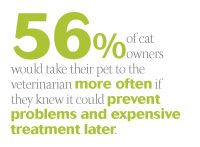
> Survey for success. Conduct periodic satisfaction surveys of clients to determine what the practice does well and what it can improve on. This communicates to clients that you want to provide the best service possible.
> Be their rock. Provide the name, phone number and e-mail address of a staff member—veterinarian or technician—whom the client can call with questions. Having an expert readily available to answer questions was one of the services that scored highest with cat owners in the Bayer Veterinary Care Usage Study III: Feline Findings.
Make the cat care commitment
So out of all of these strategies—keeping costs economical, offering monthly paid wellness plans, rewarding desired behavior, providing maximum value—what’s most important? They all are! The practice that makes a commitment to all of these tactics is the one that can count on increasing its feline business and filling many of those open appointment slots.
John Volk is a senior consultant with Brakke Consulting. Dr. Marcus G. Brown is owner of Nova Cat Clinic in Arlington, Va., and president of the American Association of Feline Practitioners. Dr. Elizabeth Colleran, DAVBP, owns Chico Hospital for Cats in Chico, Calif., and Cat Hospital of Portland in Portland, Ore.; she is also past president of AAFP.